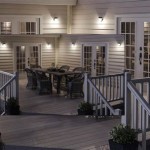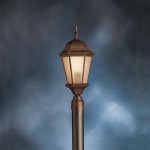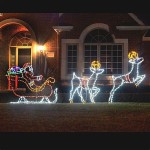Outdoor Lighting Trends Illuminating 2024 and Beyond
Outdoor lighting plays a crucial role in enhancing the ambiance, safety, and functionality of residential and commercial properties. As technology advances and design preferences evolve, outdoor lighting trends are constantly transforming. This article explores some of the key trends shaping the outdoor lighting landscape in 2024 and beyond, providing insights into the innovations and styles that are gaining prominence.
Emphasis on Sustainability and Energy Efficiency
One of the most significant and enduring trends in outdoor lighting is the increasing demand for sustainable and energy-efficient solutions. Climate change concerns and rising energy costs are driving consumers and businesses to prioritize lighting options that minimize environmental impact and reduce operational expenses. This trend manifests in several specific ways.
The widespread adoption of LED (Light Emitting Diode) technology is central to this movement. LEDs offer significantly higher energy efficiency compared to traditional incandescent and halogen bulbs. They consume considerably less power to produce the same level of illumination, resulting in lower electricity bills and reduced carbon footprint. Moreover, LEDs have a much longer lifespan, reducing the frequency of bulb replacements and minimizing waste. This extended lifespan contributes to both cost savings and environmental responsibility.
Solar-powered outdoor lighting is another prominent aspect of the sustainability trend. Solar lights harness the sun's energy through photovoltaic panels, converting sunlight into electricity that is stored in batteries. These lights operate independently of the electrical grid, eliminating electricity consumption and associated costs. Solar lighting is particularly well-suited for areas where running electrical wiring is difficult or expensive, such as pathways, gardens, and remote locations. The advancements in solar panel technology and battery storage have made solar lights more efficient and reliable, making them a viable option for a wider range of applications.
Smart lighting systems are also gaining traction as a means of optimizing energy consumption. These systems incorporate sensors, timers, and dimming capabilities to adjust lighting levels based on ambient light conditions, occupancy, and time of day. Smart lighting can automatically dim or turn off lights when they are not needed, further reducing energy waste. Many smart lighting systems are controlled via smartphone apps, allowing users to remotely monitor and adjust lighting settings for maximum efficiency. Integration with home automation systems enables even more sophisticated control and optimization of outdoor lighting.
Beyond technology, design considerations also contribute to sustainability. Light pollution is a growing concern, and designers are increasingly focusing on minimizing its impact. This involves using shielded fixtures that direct light downwards, preventing it from spilling upwards into the night sky. Careful selection of light color temperature is also important; warmer color temperatures (e.g., 2700K to 3000K) are less disruptive to wildlife and the natural environment compared to cooler, bluer light. Furthermore, minimizing the overall amount of light used is crucial. Using only the necessary amount of light for safety and functionality, rather than over-illuminating outdoor spaces, reduces energy consumption and minimizes light pollution.
Integration of Smart Technology and Connectivity
The integration of smart technology is transforming outdoor lighting, offering enhanced control, automation, and convenience. The Internet of Things (IoT) is enabling lighting systems to communicate with each other and with other smart devices, creating a more connected and responsive outdoor environment.
Smart controls provide granular control over outdoor lighting systems. Users can adjust brightness levels, color temperature, and lighting schedules remotely via smartphone apps or voice assistants. This allows for customized lighting scenarios to suit different activities and preferences. For example, brighter light levels can be set for outdoor gatherings, while softer, warmer light can be used for relaxing evenings. Automated scheduling ensures that lights turn on and off at desired times, eliminating the need for manual operation and saving energy.
Motion sensors enhance security and safety by automatically activating lights when movement is detected. This deters potential intruders and provides illumination for navigating pathways and driveways at night. Some motion sensors can be configured to trigger alerts on smartphone apps, providing real-time notifications of activity around the property.
Color-changing LED lights are becoming increasingly popular for adding a touch of personalization and ambiance to outdoor spaces. These lights can be programmed to display a wide range of colors and dynamic lighting effects, creating a festive or dramatic atmosphere. They can also be synced with music or other media, creating immersive entertainment experiences.
Integration with smart home systems allows outdoor lighting to be seamlessly integrated with other smart devices, such as security cameras, doorbells, and thermostats. For example, when a doorbell rings at night, the outdoor lights can automatically turn on to provide better visibility. Similarly, security cameras can be programmed to trigger outdoor lights when motion is detected, enhancing surveillance capabilities. This interconnectedness creates a more integrated and responsive smart home ecosystem.
Geofencing technology allows outdoor lighting to be controlled based on the user's location. For example, lights can automatically turn on when the user approaches their property and turn off when they leave. This provides a hands-free and energy-efficient way to manage outdoor lighting.
Emphasis on Design and Aesthetics
Beyond functionality and technology, design and aesthetics play a significant role in outdoor lighting trends. Homeowners and businesses are increasingly seeking lighting solutions that not only illuminate outdoor spaces but also enhance their visual appeal and complement their architectural style.
Minimalist designs are gaining popularity, characterized by clean lines, simple shapes, and understated elegance. Fixtures with sleek profiles and discreet mounting hardware blend seamlessly into the surrounding environment, allowing the light itself to take center stage. This minimalist approach is particularly well-suited for modern and contemporary homes.
Integrated lighting solutions are also becoming more prevalent. This involves incorporating lighting directly into architectural elements, such as walls, steps, and pathways. Integrated lighting creates a seamless and unobtrusive effect, enhancing the architectural features of the property. For example, LED strip lights can be integrated into stair treads to provide subtle and stylish illumination.
Landscape lighting techniques are used to highlight the natural beauty of gardens and outdoor spaces. Uplighting illuminates trees and shrubs from below, creating a dramatic and eye-catching effect. Path lighting guides visitors along walkways and pathways, ensuring safety and enhancing the ambiance. Spotlighting accentuates specific features, such as sculptures, fountains, and architectural details.
The use of natural materials, such as wood, stone, and copper, adds warmth and texture to outdoor lighting fixtures. These materials blend harmoniously with the natural environment, creating a more organic and inviting atmosphere. Fixtures made from sustainable materials are particularly appealing to environmentally conscious consumers.
The color and style of outdoor lighting fixtures should complement the overall architectural style of the property. For traditional homes, fixtures with ornate details and classic finishes are often preferred. For modern homes, sleek and minimalist fixtures with contemporary finishes are more appropriate. Careful consideration of color and style ensures that the lighting enhances the aesthetic appeal of the property.
The layering of light is a key design principle in outdoor lighting. This involves using different types of light to create depth, dimension, and visual interest. Ambient lighting provides overall illumination, while task lighting provides focused light for specific activities. Accent lighting highlights specific features and adds visual drama. By layering these different types of light, designers can create a more sophisticated and inviting outdoor environment.
In conclusion, the trends shaping outdoor lighting are a confluence of technological advancements, environmental awareness, and evolving design preferences. The shift towards sustainability, the integration of smart technology, and the emphasis on design and aesthetics are all contributing to a more innovative, efficient, and visually appealing outdoor lighting landscape. As these trends continue to evolve, outdoor lighting will play an increasingly important role in enhancing the safety, functionality, and beauty of residential and commercial properties.

10 Outdoor Lighting Trends For 2024 The Perfect Light

The Brightest Trends In Outdoor Lighting

5 Outdoor Lighting Styles And Ideas Design Inspirations Lights Com Blog

Landscape Lighting 2024 Our Perfect Vision Of Outdoor Trends Lux

10 Outdoor Lighting Trends For 2024 The Perfect Light

5 Landscape Lighting Trends Ohio Irrigation Association

Outdoor Lighting Trends For This Summer Fall Acosta

Landscape Illumination New Trends In Outdoor Lighting

15 Outdoor Lighting Trends For 2024 Hevi Lite Inc

Latest Trends In Landscape Lighting For Every Season The Lighthouse Group







